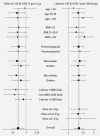Calorie intake, olive oil consumption and mammographic density among Spanish women
- PMID: 24254818
- PMCID: PMC4166692
- DOI: 10.1002/ijc.28513
Calorie intake, olive oil consumption and mammographic density among Spanish women
Abstract
High mammographic density (MD) is one of the main risk factors for development of breast cancer. To date, however, relatively few studies have evaluated the association between MD and diet. In this cross-sectional study, we assessed the association between MD (measured using Boyd's semiquantitative scale with five categories: <10%, 10-25%, 25-50%, 50-75% and >75%) and diet (measured using a food frequency questionnaire validated in a Spanish population) among 3,548 peri- and postmenopausal women drawn from seven breast cancer screening programs in Spain. Multivariate ordinal logistic regression models, adjusted for age, body mass index (BMI), energy intake and protein consumption as well as other confounders, showed an association between greater calorie intake and greater MD [odds ratio (OR) = 1.23; 95% confidence interval (CI) = 1.10-1.38, for every increase of 500 cal/day], yet high consumption of olive oil was nevertheless found to reduce the prevalence of high MD (OR = 0.86;95% CI = 0.76-0.96, for every increase of 22 g/day in olive oil consumption); and, while greater intake of whole milk was likewise associated with higher MD (OR = 1.10; 95%CI 1.00-1.20, for every increase of 200 g/day), higher consumption of protein (OR = 0.89; 95% CI 0.80-1.00, for every increase of 30 g/day) and white meat (p for trend 0.041) was found to be inversely associated with MD. Our study, the largest to date to assess the association between diet and MD, suggests that MD is associated with modifiable dietary factors, such as calorie intake and olive oil consumption. These foods could thus modulate the prevalence of high MD, and important risk marker for breast cancer.
Keywords: breast density; calorie intake; diet; mammographic density; olive oil.
© 2013 The Authors. Published by Wiley Periodicals, Inc. on behalf of UICC.
Figures


Similar articles
-
Overeating, caloric restriction and mammographic density in Spanish women. DDM-Spain study.Maturitas. 2018 Nov;117:57-63. doi: 10.1016/j.maturitas.2018.09.006. Epub 2018 Sep 29. Maturitas. 2018. PMID: 30314562
-
Consumption of sweet foods and mammographic breast density: a cross-sectional study.BMC Public Health. 2014 Jun 26;14:554. doi: 10.1186/1471-2458-14-554. BMC Public Health. 2014. PMID: 24969543 Free PMC article.
-
Olive oil consumption, BMI, and risk of obesity in Spanish adults.Obes Facts. 2012;5(1):52-9. doi: 10.1159/000336848. Epub 2012 Mar 2. Obes Facts. 2012. PMID: 22433617
-
Olive oil consumption and risk of breast cancer: Prospective results from the Moli-sani Study, and a systematic review of observational studies and randomized clinical trials.Eur J Cancer. 2025 Jun 25;224:115520. doi: 10.1016/j.ejca.2025.115520. Epub 2025 May 24. Eur J Cancer. 2025. PMID: 40449295
-
Mammographic density is not a worthwhile examination to distinguish high cancer risk women in screening.Eur Radiol. 2014 Oct;24(10):2412-6. doi: 10.1007/s00330-014-3278-7. Epub 2014 Jun 28. Eur Radiol. 2014. PMID: 24972955 Review.
Cited by
-
A Markov chain representation of the multiple testing problem.Stat Methods Med Res. 2018 Feb;27(2):364-383. doi: 10.1177/0962280216628903. Epub 2016 Mar 16. Stat Methods Med Res. 2018. PMID: 26984908 Free PMC article.
-
Milk intake and mammographic density in premenopausal women.Breast Cancer Res Treat. 2019 Feb;174(1):249-255. doi: 10.1007/s10549-018-5062-x. Epub 2018 Nov 20. Breast Cancer Res Treat. 2019. PMID: 30456438 Free PMC article.
-
Coffee, Tea, and Mammographic Breast Density in Premenopausal Women.Nutrients. 2021 Oct 28;13(11):3852. doi: 10.3390/nu13113852. Nutrients. 2021. PMID: 34836118 Free PMC article.
-
The association between breast cancer and consumption of dairy products: a systematic review.Ann Med. 2023 Dec;55(1):2198256. doi: 10.1080/07853890.2023.2198256. Ann Med. 2023. PMID: 37078247 Free PMC article.
-
International Consortium on Mammographic Density: Methodology and population diversity captured across 22 countries.Cancer Epidemiol. 2016 Feb;40:141-51. doi: 10.1016/j.canep.2015.11.015. Epub 2015 Dec 24. Cancer Epidemiol. 2016. PMID: 26724463 Free PMC article.
References
-
- Harvey JA, Bovbjerg VE. Quantitative assessment of mammographic breast density: relationship with breast cancer risk. Radiology. 2004;230:29–41. - PubMed
-
- Torres-Mejia G, De Stavola B, Allen DS, Perez-Gavilan JJ, Ferreira JM, Fentiman IS, dos Santos Silva I. Mammographic features and subsequent risk of breast cancer: a comparison of qualitative and quantitative evaluations in the Guernsey prospective studies. Cancer Epidemiol Biomarkers Prev. 2005;14:1052–9. - PubMed
-
- McCormack VA, dos Santos Silva I. Breast density and parenchymal patterns as markers of breast cancer risk: a meta-analysis. Cancer Epidemiol Biomarkers Prev. 2006;15:1159–69. - PubMed
-
- Boyd NF, Guo H, Martin LJ, Sun L, Stone J, Fishell E, Jong RA, Hislop G, Chiarelli A, Minkin S, Yaffe MJ. Mammographic density and the risk and detection of breast cancer. N Engl J Med. 2007;356:227–36. - PubMed
Publication types
MeSH terms
Substances
LinkOut - more resources
Full Text Sources
Other Literature Sources
Medical

